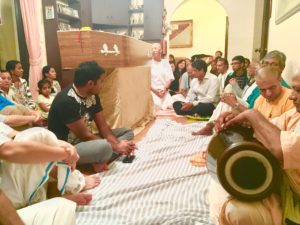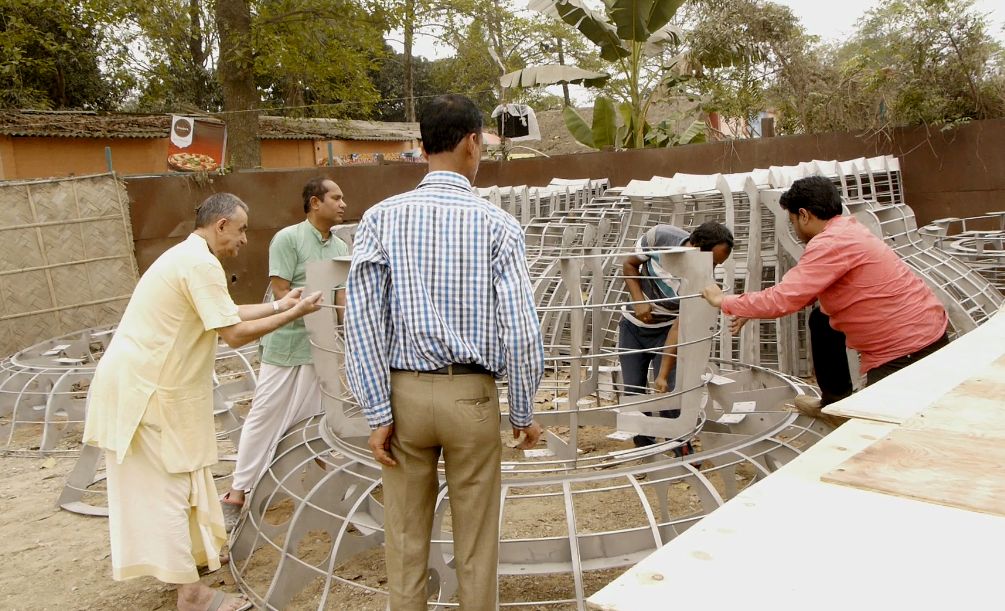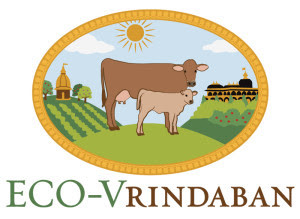
By Madhava Smullen for ISKCON New Vrindaban Communications
As residents and aficionados of ISKCON history know well, New Vrindaban winters are not exactly forgiving. And with the austerity, guests decrease, some residents go traveling, and the hustle and bustle of the summer season quietens down.
Still, the show must go on, and core crews continue on through the frigid, icy months to make sure it does.
As far as caring for New Vrindaban’s milking cows, it’s husband and wife cowherds Ananda Vidya Das and Lalita Gopi Dasi who hold down the barn. And they do so with a quiet, good-natured dedication that reveals a deep love for their service – a love that was born early on.
“When I joined ISKCON in 1990, I went to live in the Columbus women’s ashram with Malati Devi,” says Lalita Gopi. “We would visit New Vrindaban, and the first time I stopped by the cow barn, I went back home to Columbus and just cried. I said, ‘I wanna live in New Vrindaban!’ I just had this inexplicable attraction to being with the cows and the land.”
Lalita Gopi moved to New Vrindaban in 1993, where she learned how to milk a cow from Nityodita Das and got further training in cow care from ISCOWP director Balabhadra Das. From the mid 1990s, she would help on and off at the milking barn, bringing her daughters Visakha Gopi and Vrindavani with her for milkings when they were babies.
Ananda Vidya, meanwhile, joined ISKCON at New Vrindaban in 1995, but spent a lot of time away, traveling in a van as a brahmachari and book distributor for over fifteen years.
In 2013, he finally settled in New Vrindaban and began helping at the milking barn, where he and Lalita Gopi began to associate and bond over their love of the simple Brijabasi life. They were married soon after. “I really liked his Bhagavatam classes – he would tell great Krishna stories!” Lalita Gopi laughs.
That same year, Ananda Vidya began serving with ECO-Vrindaban, caring for the cows at the milking barn full-time. His wife assists him alongside taking care of her daughters, offering mangala arati at the temple and helping ISKCON New Vrindaban with landscaping.
Every day, Ananda Vidya rises, chants most of his japa at home, then makes his way down to the barn to start milking the cows at 7:00am. Between two milkings, cleaning the barn of dung, making sure the cows are fed and watered, and churning butter, his day is full, usually ending at 8pm.
Out of New Vrindaban’s fifty cows, oxen and bulls, Ananda Vidya and Lalita Gopi care for nine milking cows. They know them all by name. Laksmi, Surabhi, Yamuna, Asha, Parvati, and Usha are currently being milked, while Malati, Sita and Manjari are all pregnant. The couple also care for the calves until they’re weaned at four to six months with Vamsika, Jaya Radhe, Subhadra, and little bull Madhu currently under their wing.
Milking the cows takes an hour and a half. Ananda Vidya and Lalita Gopi try to milk as many as they can by hand. As they milk, they play Srila Prabhupada lectures, Chaitanya Charitamrita recordings by New Vrindaban’s own Damodara Das, or the morning program over the radio.
The cows yield around twenty gallons of milk in the winter and thirty in the summer. Some of this is turned into paneer, some Ananda Vidya makes into yogurt, and some he churns into about 15 to 20 pounds of butter a week. This keeps the Deity kitchen supplied with butter and ghee, and helps supplement the devotee kitchen’s needs too.
As well as all this, in the summertime the couple teaches guests – sometimes as many as one hundred visit the goshala at once – how to milk and interact with the cows, while a priest from the temple offers “go-puja.”
Ananda Vidya and Lalita Gopi’s service is often not easy. In the wintertime temperatures regularly drop below freezing. The couple have to break the ice in the water trough so that the cows can drink. They struggle to clean the barn when the cow dung is frozen to the floor and the shovel. And they’ve had to wear heavy layers of clothes and gloves, still shivering because the freezing wind blows right through cracks in the doors and walls.
Recent developments, fortunately, have made winters more manageable. Former ECO-V project manager Mukunda Das installed foam insulation in the barn, filled up all the cracks, added a layer of paneling on the walls, and put in new insulated doors; while Mother Jayasri’s son Vasudeva Gosh donated a powerful heater, turning the barn into a warm shelter.
“We’re so grateful; now we don’t have to brace ourselves when we go out to the barn anymore,” says Ananda Vidya. “It’s been so much nicer this winter.”
He and his wife do still have to be regulated and steady, performing their service day in and day out whatever happens. “It’s a bit like Deity worship,” says Ananda Vidya. “You have to be there at a specific time, twice a day, no matter what. Whatever struggles there are in your mind, you just have to surrender.”
But Krishna’s cows make any hardships surmountable.
“They’re the most loving animals,” Lalita Gopi says. “They just give. And they take care of each other – they’re so affectionate. The calves actually play games – I’ve seen them play tag, and run races, all starting in a line and belting across the field like little kids! I can understand why Krishna loves His cows so much.”
“Most people don’t get a chance to interact with cows on a regular basis – but they’re missing out, because there’s a really natural relationship between humans and cows,” adds Ananda Vidya. “They just calm you down if you’re stressed out. Being around them takes the edge off of life. And what’s more, they’re emblems of the mode of goodness – getting a chance to serve them directly has given me a lot of realizations about Vrindavan and Lord Krishna.”
He grins. “We invite you to visit us and the cows and experience it all for yourself!”
 The pious activities of one soul do not just benefit that soul but they benefit others also. It’s like when your son becomes a pious person, you are fortunate because the parents get the benefit from that piety and their destination changes. In the same way, they also get one-sixth the karma of their children. So when your children become criminals and so on, then you get one-sixth of that karma. That is quite a bit – sixteen percent! Think about it… it’s a lot… the little darlings! If you suddenly get one-sixth of the karma of all the nonsense they do, then they are not as nice as you always thought. Suddenly you start to care a little more for everything they do.
The pious activities of one soul do not just benefit that soul but they benefit others also. It’s like when your son becomes a pious person, you are fortunate because the parents get the benefit from that piety and their destination changes. In the same way, they also get one-sixth the karma of their children. So when your children become criminals and so on, then you get one-sixth of that karma. That is quite a bit – sixteen percent! Think about it… it’s a lot… the little darlings! If you suddenly get one-sixth of the karma of all the nonsense they do, then they are not as nice as you always thought. Suddenly you start to care a little more for everything they do.









 By Anuradha Devi Dasi
By Anuradha Devi Dasi 








 The Deities looked gorgeous in Their new outfit and a new unique Mridanga. When the curtains opened for darshan, devotees were showering petals on the Deities and the Mridanga. They had to be told by the pujaris to stop throwing petals on the Mridanga lest they damage it. Nobody could tell that the life-size Mridanga was actually a cake. Mother Amrita Keli very painstakingly made the unique Mridanga cake.
The Deities looked gorgeous in Their new outfit and a new unique Mridanga. When the curtains opened for darshan, devotees were showering petals on the Deities and the Mridanga. They had to be told by the pujaris to stop throwing petals on the Mridanga lest they damage it. Nobody could tell that the life-size Mridanga was actually a cake. Mother Amrita Keli very painstakingly made the unique Mridanga cake. Dear Devotees,
Dear Devotees, 
 By Indradyumna Swami
By Indradyumna Swami By Madhava Smullen
By Madhava Smullen By Parama Karuna Das
By Parama Karuna Das




